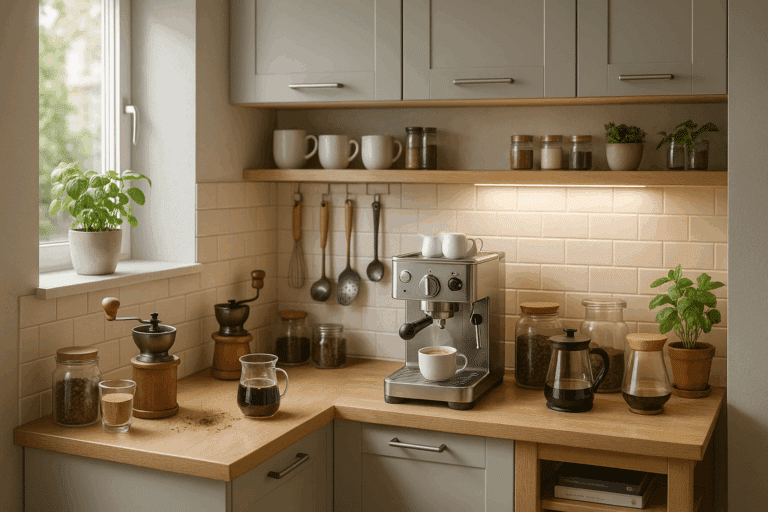The alluring aroma of freshly brewed coffee ☕, the delightful hiss of steam escaping from the espresso machine, the comforting warmth of a freshly poured cup in your hands – few experiences can parallel the appeal of a well-made brew. However, the journey to the ultimate brew experience isn’t just about the end product; it is equally about the environment in which it’s created. A clean brewing zone is the unsung hero of every superior brew. Today, we delve into the intricacies of creating clean brewing zones for the ultimate brew experience.
Why should you care about the cleanliness of your brewing zone, you may ask? Well, much like a chef needs a pristine kitchen, a brewer’s art is as good as the cleanliness of their brewing zone. The intricacies of brewing are magnified when performed in a clean, well-maintained environment, enhancing the overall experience and the resulting brew. It also brings a sense of order and efficiency that is indispensable in the brewing process.
But how does one achieve this ‘Pure Perfection’ in their brewing zone? That’s exactly what we will be discussing in this comprehensive guide. We will walk you through the process of designing and maintaining a clean brewing zone, covering a range of topics from understanding the importance of cleanliness in brewing, planning your brewing space, to tips and techniques for keeping it spotless.
Setting the Stage: Understanding the Importance of Cleanliness in Brewing
First things first, why is cleanliness so crucial in brewing? The answer is twofold. On the one hand, cleanliness plays an essential role in maintaining the quality of your brew. It prevents the growth of bacteria and yeast that can contaminate your brew, affecting its taste and safety. On the other hand, a clean brewing zone enhances the brewing experience itself, allowing for seamless operation and fostering a sense of pleasure and satisfaction in the process.
Plan Your Space: The Foundation of a Clean Brewing Zone
Before we move on to the actual cleaning, it’s essential to understand the role of planning in maintaining a clean brewing zone. A well-planned brewing space makes cleaning easier and more efficient. It minimizes clutter, ensures easy access to brewing equipment, and facilitates better organization, all of which contribute to a cleaner brewing zone.
Tips and Techniques: The Art of Keeping Your Brewing Zone Spotless
Now, let’s get down to the nitty-gritty. We will explore various tips and techniques to keep your brewing zone spotless, covering topics such as the best cleaning products to use, cleaning schedules, and more. We will also address the challenge of cleaning specific brewing equipment and share tips to tackle them effectively. By the end of this guide, you will be equipped with a comprehensive toolkit to maintain a clean brewing zone for the ultimate brew experience.
In essence, the journey to the ultimate brew experience starts with the creation of a clean brewing zone. It’s a journey that unfolds one cup at a time, each brewed in an environment of ‘Pure Perfection’. So, let’s embark on this journey together, and discover how you can elevate your brew to an art form. Ready to dive in? ☕
Mastering the Art of Brewing: A Deep Dive into Creating Clean Brewing Zones
In the world of brewing, cleanliness is not just next to godliness; it’s an essential factor in producing the perfect brew. The process of creating the ultimate brew involves more than just the right ingredients and technique. It also requires an environment that is clean and well-organized. Whether you are an amateur home brewer or a professional in a commercial setup, understanding the importance of clean brewing zones cannot be overstated. Let’s delve into the intricacies of setting up the perfect brewing space.
Brewing is a science. It involves biological and chemical reactions that need to be carried out in an optimal environment. Any contamination, whether it’s microbial or chemical, can drastically alter the final product. This is where clean brewing zones come into play. They provide a controlled environment where these reactions can take place without any interference.
To create the perfect brewing zone, one must consider factors such as the materials used, the layout of the space, the type of cleaning agents employed, and the cleaning procedures followed. All these factors contribute to the quality of the final product.
The Perfect Brew: Choosing the Right Materials
When setting up a brewing zone, the choice of materials is crucial. Materials used in the brewing process need to be able to withstand high temperatures, be resistant to corrosion and be non-reactive with the ingredients used in brewing. Common materials used include stainless steel, glass, and food-grade plastic. Each material has its pros and cons, which must be considered carefully.
Stainless steel is often the material of choice for many brewers. It is highly durable, heat-resistant, and non-reactive, making it perfect for brewing. Glass is another excellent choice. It is non-reactive, easy to clean, and allows for visual monitoring of the brewing process. However, it is more fragile than stainless steel and can break easily if not handled with care. Food-grade plastic is the least expensive option, but it can scratch easily and harbour bacteria if not cleaned thoroughly.
Below is a comparative table of the three materials commonly used in brewing:
| Material | Advantages | Disadvantages |
|---|---|---|
| Stainless Steel | Durable, heat-resistant, non-reactive | Expensive |
| Glass | Non-reactive, easy to clean, allows for visual monitoring | Fragile, can break easily |
| Food-Grade Plastic | Least expensive, lightweight | Can scratch easily, may harbour bacteria if not cleaned thoroughly |
Designing Your Brewing Zone: Layout and Space Utilization
Another essential aspect of creating a clean brewing zone is the layout and utilization of space. A well-organized brewing space can increase efficiency, minimize cross-contamination and make the brewing process more enjoyable. In designing your brewing zone, consider factors such as the size of the space, the equipment you’ll be using, and the flow of the brewing process.
A good brewing layout should have a designated space for each step of the brewing process. For example, there should be separate areas for ingredient preparation, brewing, fermentation, bottling, and storage. This separation of areas helps prevent cross-contamination and makes the brewing process more orderly. Equipment should be arranged logically, with frequently used items within easy reach.
For more insight into setting up an optimal brewing layout, check out the video “How to Set Up a Home Brewery” on the Home Brewing TV YouTube channel. It provides a comprehensive guide to setting up a home brewing space, with practical tips and advice from experienced home brewers.
The Role of Cleaning Agents in Maintaining a Clean Brewing Zone
Proper cleaning and sanitation are vital to maintaining a clean brewing zone. Different cleaning agents have different properties, and using the right one can make a significant difference in the cleanliness of your brewing space.
Alkaline cleaners, like PBW (Powdered Brewery Wash), are excellent at removing organic matter, such as hop residues, malt sugars, and yeast deposits. Acidic cleaners, on the other hand, are useful for removing mineral deposits and beer stone. Sanitizers are used after cleaning to kill any remaining bacteria, yeast, or molds. Popular sanitizers include Star San and Iodophor.
It’s essential to follow the manufacturer’s instructions when using these cleaning agents. This ensures that they are used effectively and safely. Also, remember to rinse thoroughly after cleaning to remove any residual cleaning agent, which could affect the taste of your brew.
Cleaning Procedures: Regular Maintenance for the Perfect Brew
Maintaining a regular cleaning schedule is essential to keep your brewing zone in top shape. This involves cleaning after each brew, weekly maintenance, and periodic deep cleaning.
After each brew, all equipment that came into contact with the brew should be cleaned thoroughly. This includes brewing vessels, fermenters, transfer hoses, and bottling equipment. Regular cleaning prevents the buildup of residues and bacteria, which can affect subsequent brews.
Weekly maintenance involves cleaning areas of the brewing zone that do not come into direct contact with the brew, such as work surfaces, storage areas, and brewing tools. It also involves checking for signs of wear and tear on your equipment, which could lead to contamination.
Periodic deep cleaning involves disassembling and thoroughly cleaning all your brewing equipment. This can be done every few months or after a set number of brews. It ensures that hard-to-reach areas are cleaned and any hidden residues are removed.
By implementing these practices, you’ll be well on your way to creating clean brewing zones for the ultimate brew experience. So, get out there and start brewing!

Conclusion
In conclusion, we have traversed the winding labyrinth of technical concepts, methodologies, and practices in IT and engineering. We delved into the profundities of Software Engineering, peeled back the layers of complex IT concepts, and made them accessible and comprehensible. As a result, we not only expanded our knowledge base but also equipped ourselves with the skills to navigate the challenging terrain of these sectors.
One of the significant points highlighted in this article was the importance of understanding and applying best practices in software engineering. Emphasizing the significance of using efficient algorithms, incorporating modular design, and performing rigorous testing, we explored the intricate, systematic process of building robust and reliable software. 📝💻
Furthermore, we explored the crucial role of Information Technology in today’s digital age. From empowering businesses with data-driven decision-making to facilitating seamless communication and collaboration, we uncovered how IT serves as the backbone of modern business operations. 💼🌐
Additionally, we touched upon the concepts of cybersecurity, illuminating the importance of safeguarding our digital spaces. We discussed how implementing robust security measures and adopting a proactive approach can help combat cyber threats and protect valuable information assets. 🔒🛡️
Reiterating these key points, we hope this article served as a valuable resource, enlightening you on the complexities of IT and engineering, and simplifying them to foster understanding. Given the depth and breadth of these fields, there’s always more to learn, explore, and master. We invite you to delve deeper, engage in discussions, and share your thoughts and insights. Engaging in dialogue and knowledge sharing helps us grow collectively and push the boundaries of these fields. So, let’s start a conversation! 💬👥
Remember, the journey of learning and growth is perpetual. So, continue to embrace curiosity, nurture your skills, and apply your knowledge. To further explore these subjects, consider checking out the following resources:
– Association for Computing Machinery (ACM)
– Institute of Electrical and Electronics Engineers (IEEE)
– Computer Society Technical Committee on Software Engineering (CSTCSE)
– The Cybersecurity & Infrastructure Security Agency (CISA)
Remember, knowledge is power. So, share this power with others. If you found this article helpful, feel free to share it with your network. Let’s continue to illuminate the path of knowledge and discovery together. 🚀🌟
As always, we appreciate your time and engagement. If you have any questions or suggestions, please leave a comment below. We are eager to hear from you. Keep learning, keep growing, and until next time, stay curious! 🔭🧠
Share this article: LinkedIn | Twitter | Facebook



